Some time ago the Certificate of the National Union of Artists was a status item for Ukrainian and Russian creators, whereas today a place in the short list of a prestigious award is such an item. There are such awards in Ukraine and Russia as well, some competitions offer an impressive prize fund too and understand the "art language" from creators all over the world. In 2013, this language was especially eloquent.

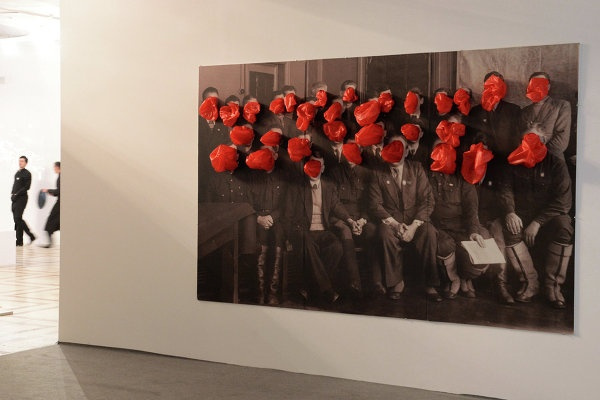
Malevich Prize, Ukraine: concrete instead of the black square
The prize, which was established by the Poles in 2008 in honour of Kazimir Malevich, the founder of Suprematism, is awarded every 2 years in December to Ukrainian artists under 40 for their significant contribution to the development of world art. The jury includes the winners of previous competitions, the director of the Polish Institute, art critics and directors of galleries. Various art institutions nominate their candidates.The list of laureates in different years included Stas Volyazlovsky and Alevtina Kakhidze, which are well-known now. They became not only the owners of the coveted 13 thousand euros, but also got the opportunity to spend 3 months in the Warsaw Centre for Contemporary Art. The prize was originally awarded for the artist’s achievements over several years of work. However, since 2010, specific projects are also taken into account. Therefore, Stas Volyazlovsky received his prize for his Gruzinoid — a pictorial symbiosis of all the stereotypes about the Caucasian nation. The author was called an adherent of chanson art: he dilutes the arrogance of museum sites with his "proletarian culture".
In 2012, the prize amount has become a bit smaller: 3000 euros from the Cultural Project Foundation and the same amount from the Polish Institute in Kyiv. The palm was won by the artist Zhanna Kadyrova, who presented to the Malevich Prize jury an installation of concrete, Implicit Forms. These are huge "asphalt" rays emanating from various light sources.

The prize-winners, led by the winner, Zhanna Kadyrova, came to the presentation of the Malevich Prize-2013 in tracksuits
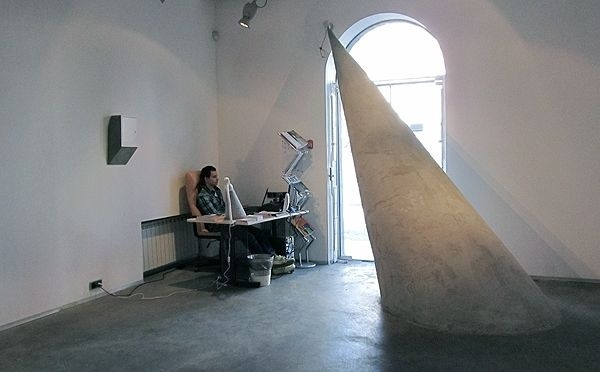
Implicit Forms by Zhanna Kadyrova
In the name of Kandinsky!
The annual Russian national Kandinsky Prize was established in 2007 by the Artchronika cultural foundation. There are two nominations: Project of the Year and Young Artist of the Year. The prize fund is 40,000 and 10,000 euros, respectively. This competition is called the most democratic, because the participants are not nominated for the award. Anyone can nominate oneself! However, it’s not that simple. The "verdict" is passed by foreign experts, curators of galleries and museums, who assess first of all how the artist influenced the Russian art process with his works. Every December, the Moscow Udarnik cinema turns into the arena for this very art process. By the way, the founder of the award, Shalva Breus, plans to turn this Soviet artifact into a museum of contemporary art.
In 2013, an emphasis was placed on "historical review". Irina Nakhova distinguished herself in the Project of the Year nomination. The conceptual work, resurrecting the era of totalitarianism "for fun", consists of a video, print and object. Spanning nearly a century, the author’s family documentary archive and photographs were the materials for the work. Here is a shabby photo of a teacher and girls in school uniforms, their faces are hastily crossed out with a ballpoint pen, just like people were deleted from history.
There appeared to be two Young Artists of the Year at once — Timofey Parshchikov with his Times New Roman. Episode 3: Moscow project, and Evgeny Granilshchikov, who presented his Positions. Times New Roman is a photographic attempt to comprehend how the bad taste of the nouveaux riches turns antique statues into kitsch pieces for mansion interiors. The winner of the prize filmed the statues of Venus and Apollo freezing on the roadside in anticipation of a purchase.
The 28-year-old video artist Granilshchikov divided his film into three screens: the beginning, middle frames, and the ending. The viewer could choose where to look. All the three screens showed one story about how the inhabitants of a neo-classical Stalinist building learn political texts.
In 2013, an emphasis was placed on "historical review". Irina Nakhova distinguished herself in the Project of the Year nomination. The conceptual work, resurrecting the era of totalitarianism "for fun", consists of a video, print and object. Spanning nearly a century, the author’s family documentary archive and photographs were the materials for the work. Here is a shabby photo of a teacher and girls in school uniforms, their faces are hastily crossed out with a ballpoint pen, just like people were deleted from history.
There appeared to be two Young Artists of the Year at once — Timofey Parshchikov with his Times New Roman. Episode 3: Moscow project, and Evgeny Granilshchikov, who presented his Positions. Times New Roman is a photographic attempt to comprehend how the bad taste of the nouveaux riches turns antique statues into kitsch pieces for mansion interiors. The winner of the prize filmed the statues of Venus and Apollo freezing on the roadside in anticipation of a purchase.
The 28-year-old video artist Granilshchikov divided his film into three screens: the beginning, middle frames, and the ending. The viewer could choose where to look. All the three screens showed one story about how the inhabitants of a neo-classical Stalinist building learn political texts.

Times New Roman. Episode 3: Moscow — The photo project by Timofey Parshchikov
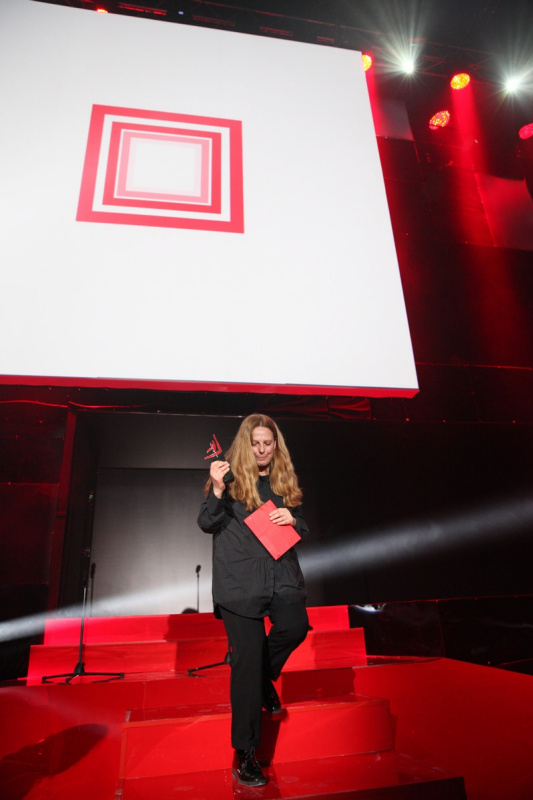
Irina Nakhova, winner of the 2013 Kandinsky Prize
The helping hand from a Ukrainian philanthropist
The International Future Generation Art Prize was founded by the foundation of the Ukrainian philanthropist and collector Viktor Pinchuk in 2009 and is awarded every two years. It implies long-term support for artists up to 35 years old working in the direction of contemporary art. The prize fund is $100,000. The winner receives 60,000 in hand, and the rest of the money in the form of a grant for the preparation of new projects.
Authoritative experts, artists, critics and art academy professors from around the world select the top 20 out of 300 participants on average. In the summer, the works of the nominees are presented to the public at the exhibition halls of the Kyiv PinchukArtCentre. The lucky one is announced in December.
Despite the triumph of media art in the world, in 2012 the winner of the competition was a completely "academicist" English artist Lynette Yiadom-Boakye with portraits of black people, "…in which dark and light are combined into a single whole". The jury noted the high quality of the paintings and the social problems reflected in them.
In addition to the Briton who took the first prize, the experts awarded five more artists (instead of the "prescribed" two!) with the Special Prize, as well as the Public Prize. A pleasant $ 20,000 was received by the Turkish Ahmet Ogut, the Brazilian Jonathas de Andrade, the Italian Micol Assael, the Lebanese Rayyane Tabet and Marwa Arsanios. They were awarded in the Kyiv Planetarium! The jury included Massimiliano Gioni (USA), Carol Yinghua Lu (China), Hans Ulrich Obrist (UK), Nancy Spector (USA), Agnaldo Farias (Brazil), Carolyn Christov-Bakargiev (Germany) and Eckhard Schneider (Ukraine).
The exhibition of their works took place within the Venice Biennale 2013, the opening of which was presented by members of the International Council of the Future Generation Art Prize: Solomon R. Guggenheim Foundation and Museum Director,
Richard Armstrong; Founder of the Elton John AIDS Foundation and Sir Elton John Photography Collection, Sir Elton John; and Patron of the Prize, artist Damien Hirst.
By the way, you could submit online applications for the competition until 12 April 2014. Obviously, it was not as calm and contemplative as the year before… Well, good luck, young people!
Authoritative experts, artists, critics and art academy professors from around the world select the top 20 out of 300 participants on average. In the summer, the works of the nominees are presented to the public at the exhibition halls of the Kyiv PinchukArtCentre. The lucky one is announced in December.
Despite the triumph of media art in the world, in 2012 the winner of the competition was a completely "academicist" English artist Lynette Yiadom-Boakye with portraits of black people, "…in which dark and light are combined into a single whole". The jury noted the high quality of the paintings and the social problems reflected in them.
In addition to the Briton who took the first prize, the experts awarded five more artists (instead of the "prescribed" two!) with the Special Prize, as well as the Public Prize. A pleasant $ 20,000 was received by the Turkish Ahmet Ogut, the Brazilian Jonathas de Andrade, the Italian Micol Assael, the Lebanese Rayyane Tabet and Marwa Arsanios. They were awarded in the Kyiv Planetarium! The jury included Massimiliano Gioni (USA), Carol Yinghua Lu (China), Hans Ulrich Obrist (UK), Nancy Spector (USA), Agnaldo Farias (Brazil), Carolyn Christov-Bakargiev (Germany) and Eckhard Schneider (Ukraine).
The exhibition of their works took place within the Venice Biennale 2013, the opening of which was presented by members of the International Council of the Future Generation Art Prize: Solomon R. Guggenheim Foundation and Museum Director,
Richard Armstrong; Founder of the Elton John AIDS Foundation and Sir Elton John Photography Collection, Sir Elton John; and Patron of the Prize, artist Damien Hirst.
By the way, you could submit online applications for the competition until 12 April 2014. Obviously, it was not as calm and contemplative as the year before… Well, good luck, young people!
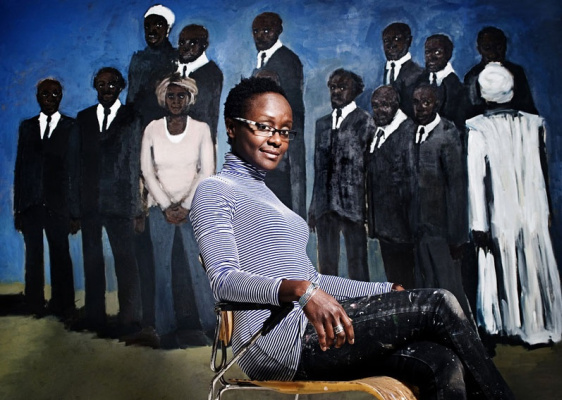
Lynette Yiadom-Boakye
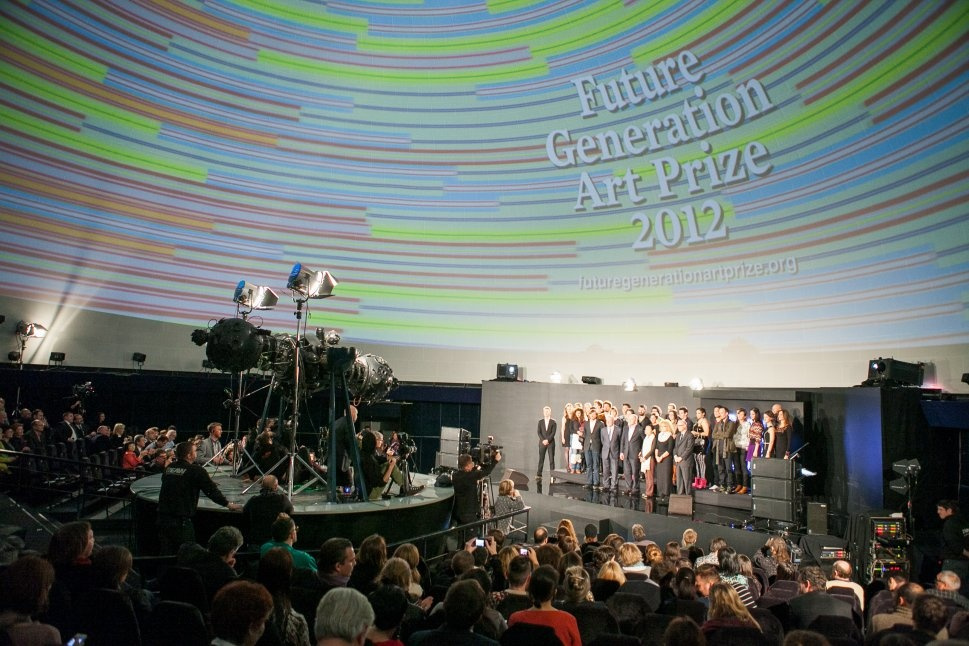
Plastov’s tricky rouble: failed…
The most expensive All-Russian award in the field of fine arts was actively advertised by its initiators, the authorities of Ulyanovsk, but failed to make the creative elite happy in 2013.
The International Prize named after Arkady Plastov, an artist from Ulyanovsk, has existed since 2010. Last year it was promisingly presented in London. The British experts were speechless then: the promised increased bonus of 20 million roubles competed with the Turner Prize fund! However, the presentation of the prize did not take place: according to the official version, "they did not have enough time to prepare the documents". By the way, the name of the philanthropist who took over the maintenance of the prize fund is unknown. As well as the size of the prize in 2013: they promise to revive the Plastov Prize.
Earlier, the jury (Russian artists, directors of state museums, members of the Russian Academy of Arts) noted realistic painting, rewarding mature artists.
Earlier, the jury (Russian artists, directors of state museums, members of the Russian Academy of Arts) noted realistic painting, rewarding mature artists.
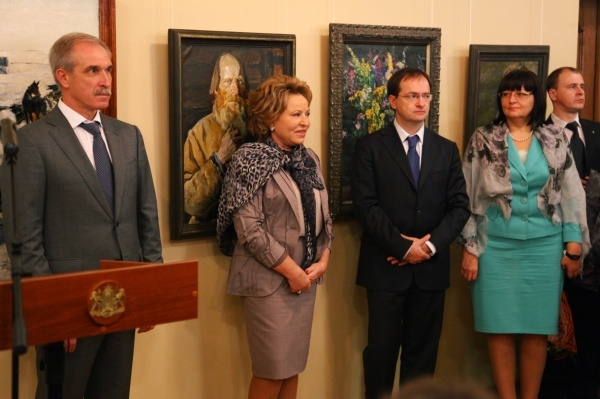
The presentation of awards in the international art arena is not only a cultural event, but a real show. Read more about it.











